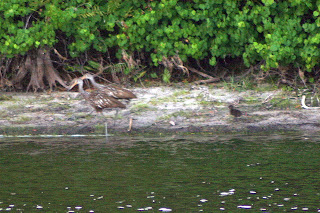My Blog List
Blog Archive
-
▼
2009
(59)
-
▼
April
(13)
- Every Evening Another Treat -Sandhill Crane
- My granddaughter, age almost-3 won one of the 15 p...
- I just had to share this cute video of my granddau...
- A History Lesson
- A duck and a Sand Hill Crane in the same shot! N...
- Evening By The Lake
- My Snowy Egret
- Listen to the Mockingbird
- Clearing the Jungle
- Bee Hive
- Here's to Old Friends
- Another Assult on the Senses
- Another Item Checked Off
-
▼
April
(13)
Every Evening Another Treat -Sandhill Crane




Cool Facts
Adult Description
- Very large bird.
- Long neck.
- Long Legs.
- Gray body, may be stained reddish.
- Red forehead.
- White cheek.
- Tufted feathers over rump.
Immature Description
Similar to adult, but mottled gray and brown, and without facial markings or bald forehead.- The Sandhill Crane does not breed until it is two to seven years old. It can live up to the age of 20. Mated pairs stay together year round, and migrate south as a group with their offspring.
The breeding map at this site shows the state of Florida and some other areas in blue...which, according to the key is Winter (non-breeding). What? We have seen MANY pairs of adults WITH their babies here in Florida; babies far too young to have migrated.
Well, maybe someone will explain this to me. On with my research:
Wikipedia says this:
The Florida Sandhill Crane is far less common, with some 5,000 individuals remaining. They are most threatened by habitat destruction and probably depend on human management in the long run. In Florida, it is protected, and if killed, carries a very high monetary penalty. This subspecies is under protection of state and federal law at this time. Since the loss of habitat is a somewhat controllable cause of a declining population, habitat preservation is a valuable management measure. The current outlook for the Florida sandhill crane, if it can be maintained on the protected habitats, is good. Transplanting wild birds, as well as introducing captive-reared birds into suitable areas where crane numbers are low, appears to be a viable technique in the management of this threatened species. It is hoped that these management strategies, plus continued ecological research, will prevent the Florida sandhill crane from reaching a more critical status.
------------------------------------------------------------------------------------
Florida Sandhill Cranes (Southwest Florida Water Management District)
Florida sandhill cranes are long-legged, long-necked, gray, heron-like birds with a patch of bald, red skin on top of their heads. Sandhill cranes fly with their necks outstretched with powerful, rhythmic wing beats. Florida's sandhill cranes are a threatened species that are found in inland shallow freshwater marshes, prairies, pastures and farmlands. Sometimes they can be seen on lawns throughout Florida. They are sensitive birds that do not adjust well to changed environments and high human populations. Sandhill cranes are usually seen in small family groups or pairs. However, during the winter, Florida's sandhill crane population increases as cranes from northern states spend the winter in Florida. Sandhill cranes are omnivorous, meaning they eat a variety of plant and animal matter. Some of their favorite meal items include seeds, plant tubers, grains, berries, insects, earthworms, mice, snakes, lizards, frogs and crayfish. Unlike other wading birds, such as herons, sandhill cranes do not "fish." The voice of the sandhill crane is one of the most distinctive bird sounds in Florida. This "call of the wild" has been described as a bugling or trumpeting sound, and can be heard for several miles. Florida sandhill cranes stay with the same mate for several years and young sandhills stay with their parents until they are about 10 months old. Like their endangered relatives the whooping cranes, sandhills live to be older than most birds. In fact, some sandhill cranes live up to 20 years.
-----------------------------------------------------------------------------------------------


0 comments: